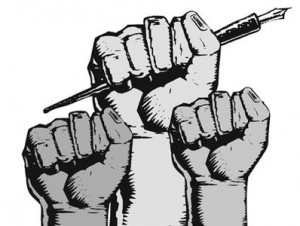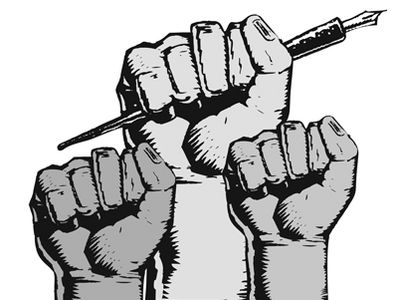Last Updated on November 4, 2013 by James Dziezynski
 Our brains are masterful at detecting subtlety.
Our brains are masterful at detecting subtlety.
Case in point: during World War II, astute observation of telegraphy messages revealed rhythmic tapping patterns that were distinct styles of a given telegraph operator. This unintentional reveal is known as a fist. Allied forces intercepting Axis messages could use this fist to determine where a certain company was, where they had moved and how engaged they were in a given campaign. The discovery and application of the telegraph fist was a major wartime advantage.
In a less serious application, a fist might be applied to musicians whose subtle patterns are unmistakable even in a contextually neutral song. It’s not that far of a stretch to say that anyone from accountants to zoo keepers exhibits similar traits in their trades.
When it comes to writing, an author’s fist goes beyond the craftsmanship and quality of their technique. If it had to be analyzed, my guess is that there are patterns in the flow of words and the literal, audible transition of sounds that reflect a mood or moment. The actual content of the writing is almost irrelevant on this level. It may be possible to detect depression in a sock review or joy in a washing machine manual.
I first noticed something of this trend in high school reading, of all people, Dave Barry. I admit to enjoying most of his silly books. While his writing isn’t aimed the academically elite, it’s solid enough to have unique character. Reading one of his newest books at the time, I sensed something was off. The material was still funny, irreverent and well-written but something else was being transmitted in the “code”. Later on, I read that Barry had been going through a messy divorce in that time span. This wasn’t public knowledge and there was nothing actually written about it in his book, but at the same time there was a noticeable shift in the way his words were put together.
There is something beyond the content of a piece that archives it within a given era of a writer’s life. If you read a specific author for long enough, chances are you will pick up on their fist and may very well feel a change when something about that underlying style is affected.
Having written professionally for 15 years, I sometimes stumble across my work at unexpected times. A Google search might spring up articles or blogs from 2002, 2004, 2008, etc. Because every writer is also their own primary audience, it’s really interesting to see the fist in my work from my own eras. Sometimes the trend is obvious: when times were good, it’s easy to see the fun, vibrant energy in a piece. When things were bad, it’s equally easy to see the sorrow and distress.
However, I’ve been shocked how well I’ve been able to figure out when I wrote a piece by dissecting service pieces. Writing for hotels, say, or lawn mowers or cat food or hiking poles. Each and every piece has enough loaded information between the lines to capture a stage of life. It’s still subtle and I’m not sure I can even put it into words, but it’s there. Just like the piece you are reading right now.
We live in a coded world. In fact, it may very well be the meaning of our existence to become savvy code breakers as we uncover the science of the universe, the complexity of attraction or the value of spirituality. Somewhere between blatant intention and conspiracy theory is a seamless code, one that must manifest itself in a variety of our actions and thoughts. Detection of this code is at the heart of intuition.
The fact the code gets embedded in the first place is an amazing, autonomous act that is every bit as natural as breathing.





